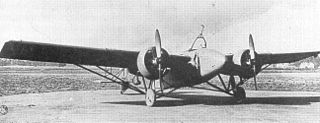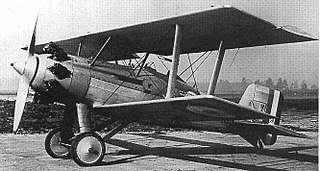
The Boulton & Paul P.64 Mailplane also known as the Mail-Carrier was a 1930s British twin-engined all-metal biplane transport aircraft designed for Imperial Airways and built by Boulton & Paul Ltd.

The Boulton & Paul P.71A was a 1930s British twin-engined all-metal biplane transport aircraft developed by Boulton & Paul Ltd from the unsuccessful P.64 Mailplane to meet an Imperial Airways requirement for a mail plane.

The Avro 701 Athena is a British advanced trainer aircraft built by Avro in the late 1940s. It was designed to replace the North American Harvard in the Royal Air Force, but was bought only in small numbers, the competing Boulton Paul Balliol being preferred.

The Avro Type E, Type 500, and Type 502 made up a family of early British military aircraft, regarded by Alliott Verdon Roe as his firm's first truly successful design. It was a forerunner of the Avro 504, one of the outstanding aircraft of the First World War.

The BAT F.K.24 Baboon was a British two-seat training biplane produced by British Aerial Transport Company Limited of London during World War I.

The Blackburn Bluebird IV was a single-engine biplane light trainer/tourer biplane with side-by-side seating designed by Blackburn Aircraft. It was an all-metal development of the wooden Blackburn Bluebird I, II and III aircraft.

The Caproni Ca.165 was an Italian biplane fighter developed just before World War II, but produced only as a prototype, as the competing Fiat CR.42 Falco was selected for series production.

The Boulton Paul Bittern was a 1920s British night-fighter aircraft built by Boulton Paul Limited of Norwich, named after the marsh bird of the same name.

The Westland Widgeon was a British light aircraft of the 1920s. A single-engined parasol monoplane, the Widgeon was built in small numbers before Westland abandoned production in 1929.

The Short Silver Streak was the first British all-metal aircraft. It was designed and built by Short Brothers at Rochester, Kent, England. Although Flight magazine claimed that it was the first instance of stressed skin construction in the world, it was preceded by a number of Dornier designs, including the Dornier-Zeppelin D.I, which was ordered into production.

The Sopwith Atlantic was an experimental British long-range aircraft of 1919. It was a single-engined biplane that was designed and built to be the first aeroplane to cross the Atlantic Ocean non-stop. It took off on an attempt to cross the Atlantic from Newfoundland on 18 May 1919, but ditched during the flight owing to an overheating engine.

The Boulton & Paul P.33 Partridge was a single seat single-engined biplane fighter designed to an Air Ministry specification. One prototype was ordered and built for trials in 1928, but it was not put into production.
The Boulton & Paul P.12 Bodmin was an experimental British twin-engined biplane bomber with its engines mounted in a fuselage engine room and with tandem pairs of tractor and pusher airscrews mounted between the wings. The two Bodmins built flew in 1924, proving the concept but the layout was not developed to production.

The Boulton & Paul P.15 Bolton was a one-off experimental twin-engined reconnaissance biplane ordered by the Air Ministry to sustain Boulton & Paul's development of steel-framed aircraft early in the 1920s. It was the RAF's first metal-framed aircraft.

The Boulton & Paul P.8 Atlantic was Boulton & Paul's attempt to adapt their well-performing Bourges bomber into an airliner. They hoped to gain publicity for it by winning the outstanding prize for the first non-stop Atlantic crossing but a first flight accident made them miss their opportunity. Two were built but none sold as airliners.
The Boulton & Paul P.6 was a one-off conventional single-engined biplane built by Boulton & Paul Ltd to test the aerodynamics of different airfoil sections. It was later used as the company sales machine.

The Boulton & Paul P.10 was a two-seat, single-engined biplane built just after World War I to develop techniques for the construction of all steel aircraft. It is also notable for its first use of plastic as a structural material. Only one P.10 was built and it attracted much attention; but it probably never flew.

The Boeing XPB was an American twin-engined biplane long-range patrol flying boat of the 1920s. A single example was built for the United States Navy.
The Bird Wing or later, Bird Wing Imperial was a light sport biplane of the 1920s and 1930s.

The Short S.36 was a British two-seat tractor biplane, built by Short Brothers for Francis McClean in 1911. It was later developed into the Short S.41 and Short S.45, which were the first of a long series of similar aircraft built for the RNAS and RFC.

















